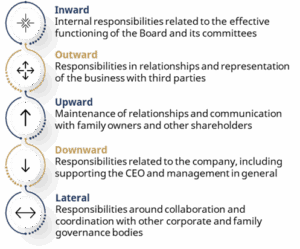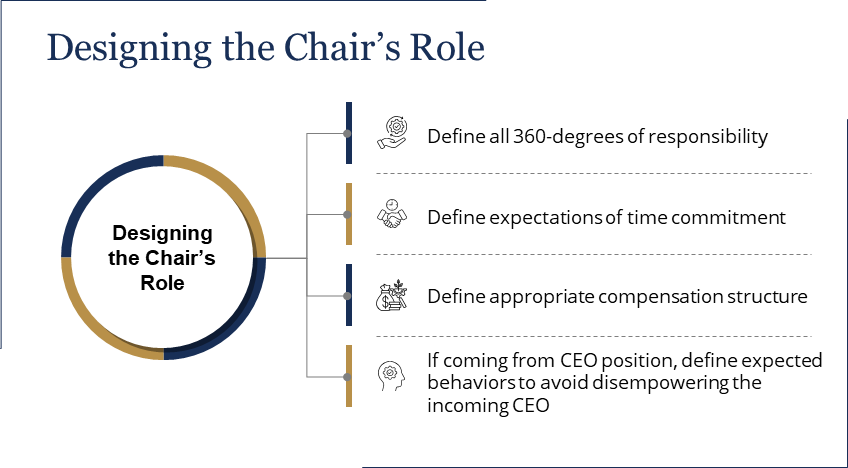Beyond the Boardroom: A 360 View of the Board Chair in a Family Enterprise
In most businesses, the Board Chair’s role is seen as relatively straightforward: to ensure the Board and its governance committees function properly. However, in family enterprises, this role is far more complex, with responsibilities that go significantly beyond these traditional expectations. In fact, it’s a more multi-faceted role, with many critical responsibilities related to governance of the entire enterprise.
The responsibilities of the Board Chair in the family enterprise fall naturally into five distinct categories, reflecting the Chair’s accountability to a wide array of important stakeholders: inward (the Board itself); outward (outside parties); upward (owners), downward (management); and lateral (other corporate and governance bodies.
It is only through the fuller understanding of the Chair’s expanded role that we can see the full impact of these leaders on the enduring continuity of the family enterprise system.
To illustrate the varying demands of this role, we will begin with two brief examples of Board Chairs with distinct responsibilities before exploring these 360-degree components in detail.
A Tale of Two Board Chairs
Jonathan, a 3rd generation family member, serves as the Chair of a prominent family enterprise in the home improvement retail sector. His role is both demanding and multifaceted. He regularly engages with the President of the Family Council to address family shareholder concerns, such as a plant acquisition in a country with human rights issues, and to prepare the agenda for the CEO’s quarterly meetings with the family. Jonathan also acts as a sounding board for the CEO on significant operational decisions, such as those concerning key commercial suppliers and related pricing frictions.
His responsibilities also extend to various external stakeholders, including consulting corporate lawyers on bylaw changes and meeting with government officials to discuss trade agreements. Furthermore, Jonathan meticulously oversees matters of corporate governance, including crafting detailed Board agendas and ensuring information is shared with members in a timely manner. He consistently promotes collaborative decision-making, fosters harmonious relationships between family and non-family directors, and ensures the Board’s guidance is implemented. This extensive role means Jonathan works full-time as Chair, maintains an office at corporate headquarters, and receives market-based compensation.
Now consider Susan, a 4th generation family member heading the Board of a successful glass manufacturing business owned by her family, who operates with a significantly narrower scope. Unlike Jonathan, she does not work full-time in her governance role, being the high-performing CEO of an entirely separate pharmaceutical business. Susan’s responsibilities as Chair are more conventional and primarily limited to ensuring the proper functioning of the Board. This often involves communicating with the CEO several times per quarter to set agendas and track decision implementation, and annually coordinating board and director evaluations with external advisors. Beyond that, she functions as any other board member, without an office in the family enterprise, attending only the quarterly board meetings, and receiving compensation commensurate with her circumscribed duties.
The preceding examples demonstrate the diverse range of responsibilities a Board Chair can hold within a family enterprise. To fully grasp the potential scale and scope of this role, it’s essential to examine it comprehensively, considering 360-degrees of responsibility across five distinct categories:

As the earlier examples suggest, the work of a Chair can vary widely, with no single formula or recipe. The needs of each family enterprise will inevitably differ, based on their specific context and developmental stage. Indeed, depending on the circumstances and needs of the company, its owners, the family, and the Board, the Chair’s role can be narrow and focused like Susan’s, broad and expansive like Jonathan’s, or fall at any point in between.
Let’s consider in more detail each of the categories to better understand how each family needs to set these critical levers for themselves, rather than borrow from corporate governance “best practices” or simply tailoring to suit the current incumbent.
The Chair’s Inward Responsibilities: Ensuring Effective Functioning of the Board and its Committees
The activities in this category are typically considered the primary responsibility of the Chair: ensuring the effective functioning of the Board and its related Committees. These often include creating orderly Board agendas, organizing meeting schedules, facilitating effective discussions, ensuring that preparatory information reaches directors in a timely manner, ensuring sufficient discussion and debate to support effective decision-making, and conducting regular Board evaluations. A crucial aspect of facilitating effective decision-making discussions is the Chair’s responsibility to stimulate and synthesize Board discussions, framing decision choices and options clearly. This ensures that after a robust exchange of opinions, directors are fully aware of the range of options available, and a clear decision is made and documented to avoid unambiguity. Furthermore, the Chair is responsible for effectively transmitting the Board’s decisions to management (and to shareholders when appropriate) to ensure diligent follow-up, and implementation, and oversight.
Additionally, it is the Chair’s responsibility to ensure that the Board’s composition is appropriate in terms of size and member profiles. This entails an ongoing effort to ensure the Board has the right mix of skills, experiences, and perspectives to effectively oversee the company and to provide strategic guidance. The Chair must assess whether the current number of directors is optimal for efficient decision-making and diverse input, and actively seek out candidates with profiles that complement the existing strengths and address any gaps. Furthermore, as the business evolves and new challenges and opportunities arise, the Chair is instrumental in identifying the need for, and then establishing, specialized Board committees (such as audit, compensation, and governance committees) to delve deeper into specific areas of focus and enhance the Board’s oversight capabilities. This proactive approach to Board composition and committee structure is vital for maintaining a dynamic and effective governance body.
Furthermore, a critical responsibility of the Chair in a family business is managing the director’s succession process and their own succession plan. This includes monitoring when directors are nearing the ends of their terms, —whether due to retirement age or other factors—and ensuring the availability of well-qualified successors.
To be clear, the Chair of any business—family enterprise or not—will have these same inward-facing responsibilities. However, on family business Boards, especially those with independent directors, the Chair’s role ensuring all directors can freely and candidly express their ideas is crucial. This is because independent directors may find it difficult to challenge the prevailing wisdom, as family directors dominate discussions. Therefore, the Chair must be intentional about actively engaging each director, providing the necessary time and space for them to share their opinions. Effective Chairs are also conscious of the various roles directors hold on the Board—whether they are independent, management, or family directors. They actively work to elicit the perspectives of these diverse constituencies, ensuring that issues are thoroughly explored from multiple vantage points.
The Chair’s Outward Responsibilities: Chief Ambassador
This category includes the responsibility some family businesses assign to the Chair of being the face of the company for the media, industry associations, or government officials, among others. Jonathan’s role from the opening example reflects many of these responsibilities.
The crucial decision of who serves as the primary spokesperson for a family enterprise is deeply intertwined with the family’s overarching priorities and strategic vision. This choice is not merely an administrative one—it reflects the internal dynamics, external messaging, and desired allocation of leadership responsibilities across the enterprise.
In many family businesses, a common practice is to designate the Chair of the Board as the official company representative for external communications. This approach is often adopted to free the CEO from the demands of public-facing duties, allowing them to channel their full attention and expertise into core business operations, strategic planning, and internal oversight. When the Chair assumes the spokesperson role, they typically represent the long-term vision, governance principles, and family legacy, offering a consistent message about the family’s commitment to stewardship and continuity. This can be particularly beneficial during periods of significant growth, restructuring, or when navigating turbulent times, as it ensures the CEO remains unburdened and focused on day-to-day tactical execution and operational excellence. The Chair, often a more seasoned and less operationally-focused leader, can bring a broader, more detached perspective to public statements, reinforcing the company’s foundational mission and values.
However, there are equally compelling circumstances where it proves more advantageous and sensible to assign outward-facing responsibilities to the CEO. This alternative is often preferred when the company’s public image needs to be directly tied to its operational achievements, innovation, or aggressive market strategies. When the CEO is a dynamic leader with a strong public presence and a deep understanding of the company’s products, services, and immediate market position, making them the spokesperson can convey a sense of confidence, agility, and hands-on leadership. This approach can be particularly effective in fast-paced industries, during product launches, or when family leadership is in transition. Furthermore, if the CEO is also a family member, their direct engagement as spokesperson can lend authenticity and a personal touch to the company’s narrative, fostering stronger connections with customers, investors, and the public. The decision ultimately hinges on whether the family believes the company’s public narrative should be primarily driven by long-term vision and governance (Chair) or by operational dynamism and market responsiveness (CEO).
In those situations when the Chair is acting as the face of the company, it is critical for the CEO and Chair to coordinate, in order to present a unified, coherent message to external stakeholders. For example, one family enterprise in the sugar industry understands the importance of having an owner’s voice in government and industry discussions, which can shape the regulatory environment and related export policies. Since the CEO isn’t a family member, the shareholders have appointed the Board Chair to represent them in these important external affairs.
Third-party partners are another key stakeholder group in this category that needs to be managed with strategic intention. For most family enterprises, cultural alignment with partners is a top priority, often superseding initial business discussions. Family members have a better understanding of their values and principles and are better equipped to evaluate cultural compatibility. Therefore, these relationships are often overseen by family members— particularly the Chair— or by a family representative working alongside an external Chair.
The Chair’s Downward Responsibilities: Supporting Management
In contrast with external relations, there is often little ambiguity that the Chair is the primary communication channel between the Board and the CEO, ensuring that the Board’s guidance and decisions are implemented within the company.
Furthermore, a close relationship between Chair and CEO has significant benefits for the business, owners and family members. For example, during transition periods, especially when transitioning to a CEO that does not come from within the business -family or not-, it is likely in the interest of the owning family for the Chair to maintain a strong relationship with the CEO. This ensures that the CEO understands the enterprise culture and can quickly learn to navigate the family dynamics and governance system while respecting the family’s values.
Additionally, there are times when the CEO must make decisions for which they already have authority but would still benefit from having a sounding board, the case of Jonathan demonstrated above. In these cases, the Chair’s support and validation are valuable contributions to executive decision-making and will help to forge a strong working relationship with the CEO and alignment with the family.
It’s important to highlight that while the CEO and Chair can meet as often as needed to discuss these matters, the CEO should have full authority, freedom, and support from the Chair when it comes to how they manage the business. The key point is that the Chair should support management without interfering and undermining the CEO’s authority, or this critical relationship is destined to break down. In the example of Jonathan above, the CEO had autonomy to make a decision about the supplier on her own, but benefited from leveraging input from the Chair as a sounding board. Similarly, Susan’s regular but infrequent meetings with her CEO ensured ongoing communication and oversight with minimal interference.
The effectiveness of this structure hinges on both the Chair and the CEO clearly understanding their distinct roles. However, there are moments when the boundaries between governance and management can become blurred, particularly when the company faces difficulties, leadership is in transition, or shareholders become nervous, leading the Board to be naturally less inclined to grant the CEO complete autonomy. It is also worth noting that some companies adopt an “Executive Chair” model, where the delineation between the CEO and Chair roles is even more permeable, given that the CEO reports to the Executive Chairman and not directly to the Board. Regardless of the specific model, the essential point remains that the Chair and CEO must operate as a cohesive team for the overall leadership function at the apex of the organization to work effectively.
The Chair’s Upward Responsibilities: Shareholder Relations
This category concerns the Chair’s responsibility to ensure that shareholder interests are well-represented on the Board and to help create and maintain effective communication channels and appropriate accountability processes. The shareholders appoint the Board of Directors and delegate to them the responsibility of overseeing the company. As such, in family businesses, the Chair must maintain a relationship with shareholders that builds trust and provides a sense of reassurance. This relationship is a two-way function: not only does the Chair ensure that the interests, values, and priorities of the owners are well-represented on the Board, but they must also work to ensure the shareholders understand the Board—its function, its structure, and the decisions it makes. Working continuously to nurture the unity of the family and its commitment to the enterprise is a key part of this “upward” responsibility.
As shareholders are the ultimate appointing authority for the Board of Directors, entrusting them with the oversight of the company, the Chair carries a significant responsibility to cultivate and maintain a relationship founded on trust and reassurance. In family businesses, this responsibility takes on an even more profound significance. The Chair must actively engage with shareholders in a manner that consistently builds trust and provides a sense of security regarding their investments and the family’s unity and entrepreneurial legacy.
The Chair’s primary duty is to ensure that the diverse interests, core values, and strategic priorities of the owners are not only heard but are also genuinely and effectively represented within the deliberations and decision-making processes of the Board. This involves understanding the nuances of shareholder expectations, whether they relate to financial performance, long-term sustainability, or adherence to specific family values.
Equally important is the Chair’s responsibility to educate shareholders about the Board itself. This includes explaining the Board’s strategic role, its oversight responsibilities, and its contribution to the company’s success, detailing the composition of the Board, the roles of individual directors, and the various committees that support its work, and providing clear and concise explanations for the significant decisions made by the Board, outlining the rationale behind them and their potential impact on the company and its shareholders. This transparency is crucial for maintaining confidence and preventing misunderstandings.
Within the context of a family business, this “upward” responsibility extends beyond mere corporate governance. A key part of the Chair’s role is to continuously work towards nurturing the unity of the family and reinforcing their collective commitment to the enterprise. This involves facilitating open dialogue, mediating potential conflicts, and ensuring that the long-term vision for the business aligns with the aspirations of the owning family. By fostering a strong sense of shared purpose and dedication, the Chair helps to safeguard the longevity and success of the family business for future generations.
The Chair’s Lateral Responsibilities: Collaborating with Other Governance Bodies
Another common responsibility of the Chair is to ensure that the entire governance system functions effectively. Family businesses generally have separate entities responsible for decision-making around family issues (e.g. Family Council, Family Foundations), business matters (e.g. Board of Directors), and ownership issues (e.g. Owners Council, Family Office). Consequently, for the governance system to work well, there must be effective coordination across these core functions, and leaders must maintain regular and proactive communication, as we saw with Jonathan’s frequent interactions with the Family Council President.
Families often empower the Board Chair to establish effective communication channels and mechanisms across these disparate governance entities, ensuring effective functioning of the family enterprise’s overall governance system.
Finally, families should design their governance structures with a forward-looking lens, anticipating what will be needed before it is required, while avoiding the creation of unnecessary or overly complex structures. Enduring enterprises take a developmental perspective, foreseeing future challenges and their impact on governance structures, policies, and processes, rather than waiting until the current system breaks down and change becomes a strictly reactive exercise. The Board Chair is often well-positioned to lead these integrated processes as a result of the holistic perspective their role provides. The most effective Chairs have a unique ability to see the system as a whole and, with the support of a Governance Committee, to assess whether the various components are fitting well together, the right people are in the right positions, the distribution of authority is appropriate, checks and balances are working effectively, and accountability systems among all these entities are functioning well.
Common Challenge: A Lack of Clarity
Considering the broad scope of the Chair’s potential responsibilities, it is easy to understand the importance of clarifying this role, given the many complex challenges families need to address. Indeed, poor clarity about the scope of the Chair’s role may lead to unreasonable expectations and conflicts that hinder them from performing their duties effectively. Therefore, it is of the utmost importance to establish clarity upfront about the nature and scope of these responsibilities.
This is particularly true for those with long careers in the company, and especially for those who have served as CEO; they inevitably carry some elements of their leadership experience into the new Board role, making the transition from operations into governance more challenging. Such operators often struggle to stop seeing themselves as directly involved in the business, and it is not enough simply to change their titles. Attitudes and behaviors must also evolve in light of these new responsibilities, both to ensure that the Board is being properly managed, and to give the new CEO the opportunity to earn credibility and respect and make their own mark in the business.
In these cases, new Chairs ought to see their role as an opportunity to truly impact the enterprise’s enduring success, but at a fundamentally higher level. Their new focus should be developing the best governance system possible to fulfill the family’s shared purpose and long-term vision. Taking a 360-degree view of the Chair’s role, therefore, is essential for making this happen.
Designing the Chair’s position
Both our research and experience suggest that there is no one-size-fits-all approach to defining the Chair’s role. The specific context and developmental stage of each family enterprise, along with the organizational structure, governance architecture, and family culture, all powerfully shape the Chair’s ideal scope. For those less sure about how to define the role for their own family enterprise, consider the following:
- Begin by defining all 360-degrees of responsibility. Establishing a clear scope is crucial to prevent misunderstandings and conflicts that could hinder performance. Outline the inward, outward, upward, downward, and lateral duties, tailored to the specific needs of the family, the company, and the Board.
- Next define expectations of time commitment. The time commitment required for the Chair role can vary significantly, from a full-time engagement like Jonathan’s to a more circumscribed role like Susan’s. Clearly defining these expectations, grounded in a 360-view of these responsibilities, ensures that the individual stepping into the role understands the demands and can dedicate the appropriate amount of time.
- Then define an appropriate compensation structure. Compensation should be commensurate with the time and effort invested, as well as the breadth of responsibilities undertaken by the Chair. This helps to attract and retain qualified individuals for this critical position. Some families choose to compensate at market-based rates, while others will pay above- or below-market rates. This is typically tied to the unique culture of each family, and should be clarified before recruiting an individual into this role.
- If a candidate is transitioning to become Chair from an existing CEO role, it is critical to define expected behaviors to avoid disempowering the incoming CEO. This includes defining new behaviors and attitudes that will support the incoming CEO’s authority and ability to make their own mark. This ensures a smooth transition and prevents unintentional interference with the new management.










